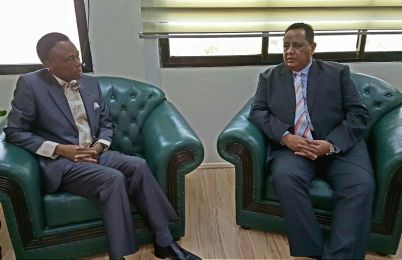Sudan holds SLM-AW responsible for Jebel Marra clashes
March 13, 2016 (KHARTOUM) – Sudan’s foreign minister Ibrahim Ghandour has held the rebel Sudan Liberation Movement (SLM-AW) led by Abdel-Wahid al-Nur fully responsible for the ongoing clashes in Jebel Marra.

Ghandour told the Joint Special Representative for Darfur and head of the hybrid peacekeeping mission in Darfur (UNAMID) Martin Uhomoibhi Sunday that al-Nur continued to call for overthrowing the government via military action, adding he holds civilians captives and imposes taxes and royalties on them in areas under his control.
Ghandour further said that the army managed to defeat the rebellion, pointing that students are currently taking the high school exams for the first time in Jebel Marra since thirteen years.
He pointed to the conflicting figures of the IDP’s issued by various bodies, saying his government seeks to return the IDP’s to their original villages and help them resume their ordinary lives.
In a press statement late last month, the US States Department spokesperson, John Kirby, accused the SLM-AW of initiating attacks on the Sudanese army in Jebel Marra. However, the SLM-AW dismissed Kirby’s claims as “baseless and unfounded accusations” saying it did not initiate the attacks on Jebel Marra.
But the rebel group denied the accusations and claimed that Washington seeks an excuse to normalize relations with the Sudanese government.
The UN Office for the Coordination of Humanitarian Affairs (OCHA) in Sudan reported that more than 105,000 people are estimated to be displaced by the Jebel Marra clashes. But, the Sudanese government says the number of persons fleeing the fighting doesn’t exceed 73,000 people.
For his part, Uhomoibhi briefed Ghandour on the outcome of his visit to Doha last month, saying he discussed with the Qatari officials the peace process in Darfur and the ongoing efforts to allow other rebel groups to join the Doha Document for Peace in Darfur (DDPD).
The Sudanese army has been fighting a group of armed movements in Darfur since 2003.
Doha brokered the Darfur peace negotiations which resulted in the signing of the DDPD by the Sudanese government and the Liberation and Justice Movement (LJM) in July 2011. Also, a dissident faction of the Justice and Equality Movement (JEM) joined the DDPD in April 2013.
JEM led by Gibril Ibrahim and the SLM-MM led by Minni Minnawi have engaged in peace talks with the government under the auspices of the African Union.
SLM-AW, however, is not part of the African Union mediated peace talks. The rebel group rejects negotiating a peace agreement with Khartoum government, unless the government militias are disarmed and displaced civilians return to their original areas.
UNAMID EXIT STRATEGY
Meanwhile, Sudan’s foreign ministry spokesperson Ali al-Sadig told reporters Sunday that the tripartite team tasked with developing an exit strategy for the UNAMID would meet in New York on March 20 th.
He said the team would resume discussions on the mission’s exit according to criteria the put forward by the UN Security Council (UNSC) and the African Union Peace and Security Council (AUPSC).
A tripartite committee including the Sudanese government, AU and UN has been set up in February 2015 to develop an exit strategy for the UNAMID from Darfur.
The committee was expected to sign an agreement last May. But in June, Sudanese officials said that the UN retracted from an agreement reached by the joint team on an exit strategy.
The hybrid mission has been deployed in Darfur since December 2007 with a mandate to stem violence against civilians in the restive region.
It is the world’s second largest international peacekeeping force with an annual budget of $1.35 billion and almost 20,000 troops.
KILLING OF SOUTH AFRICAN PEACEKEEPER
Al-Sadig described the joint statement issued by the African Union and the United Nations on the killing of a South African peacekeeper in North Darfur as “unclear”
On Wednesday, unidentified gunmen killed a South African soldier in an ambush on a patrol of the hybrid peacekeeping mission, 40 km south west of Kutum, North Darfur.
In a statement on Thursday, the deadly ambush was condemned by Chairperson of the AU Commission, Nkosazana Dlamini-Zuma, the UN chief, Ban Ki-moon.
The two leaders called on the warring parties in Darfur to respect the integrity of the peacekeeping mission. Also they urged the Sudanese government to probe the attack and bring the culprits to book.
Al-Sadig said the concerned bodies are still collecting information on the killing incident, pointing that the statement issued by the AU and UN was “unclear” and “written in haste”.
(ST)
